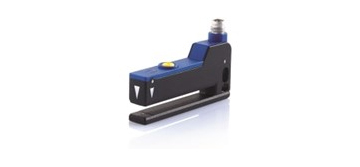
White Papers
White Papers
What is a photoelectric sensor?
Photoelectric sensors are industrial electronic devices used to detect the presence of objects by means of light.
Datasensing qualifies as of the one of world main photoelectric sensors manufacturers, after merging Datalogic and M.D. Micro Detectors, two companies that have made the history of photoelectric sensors in Italy since the early 1970s.
So, who better to explain this matter?
Photoelectric sensor working principle
Photoelectric sensors are based on emission and detection of light, which is a form of electromagnetic radiation with wavelength ranging from infrared to ultraviolet.
When the light hits an object, three effects take place: Reflection (ρ), Absorption (α), Transmission (τ); with ratios depending on objects, material, surface, thickness, or color.
Therefore, we can detect object by measuring these parameters with a photoelectric sensor.
Photoelectric sensor: how it’s made?
Photoelectric devices consist basically in the following six stages:
- a photo-emitter generates light pulses* distinguished from other continuous light sources;
- an optic system connects the emitter and the receiver of light;
- a photo-receiver converts the received light into an electric signal;
- a demodulator-amplifier extracts and amplifies the received signal;
- a comparator stage compares the received signal with a switching threshold;
- a transistor or relay power output drives an external actuator or directly the load.
*The light emission is typically infrared or visible red and is generated by a LED, or even a Laser, which offers beam focusing advantages to detect smaller objects or reach greater operating distances.
Photoelectric sensor types
Photoelectric sensors types can be distinguished by optical functions, used for different object detection in a wide spectrum of applications.
The basic optic functions are through beam, retro-reflective and diffuse.
Furthermore, photoelectric sensors can vary in their housing shape and dimensions, according to the requested detection performances, such as operating distances or resolution.
Through beam photoelectric sensor
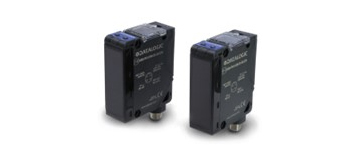 The light emitter and receiver of a through beam photoelectric sensor are contained in two separate units, which are placed one in front of the other.
The light emitter and receiver of a through beam photoelectric sensor are contained in two separate units, which are placed one in front of the other.
The light beam emitted hits the receiver; so that each object that interrupts the light is detected. This sensor type offers the maximum excess gain, so it can reach operating distance up to 50 meters or beyond, and can operate in the harshest environmental conditions, such as in presence of dirt or dust.
The disadvantage consists in having to install and wire two different emitter and receiver units. Through beam type typically operates in dark mode: the output is on when the object interrupts the beam between emitter and receiver. The model coding used by Datasensing for the through-beam type is "F/G" (receiver/emitter). The maximum operating distance of 60 m can be achieved in the S300-PR series.
Photoelectric fork sensor
This is a particular version of the through beam photoelectric sensor.
Emitter and receiver are positioned frontally on the internal sides of a U-shaped housing, thus creating a fork.
Any object that passes through the fork interrupts the beam and is detected.
Due to their construction, fork sensors are limited to applications with operating distances of some millimeters.
Fork sensor applications are hole or teeth detection on wheels, label detection on thin supports, or the control of edge and continuity of sheets and tapes.
The best fork sensor for label detection is the SR23 series
Retro reflective photoelectric sensor
In retro reflective photoelectric sensor both the emitter and receiver are inside the same housing.
In this case the emitted light beam is reflected to the receiver thanks to a reflector.
When the light beam is interrupted by an object, a detection occurs.
With respect to the through beam optic function, the signal difference is reduced, so the excess gain is lower, and the maximum operating distance results in about half the through beam.
Moreover, it is necessary to operate in a cleaner environments without dirt or dust.
Retro-reflective type typically operates in dark mode: the output is on when an object interrupts the light beam between the sensor and reflector.
The model coding used by Datasensing for the retro reflective type is "A", although this version is no longer used superseded by the polarized version (see below).
Polarized retro reflective photoelectric sensor
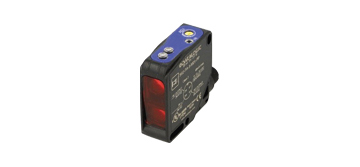 Retro reflective photoelectric sensors with polarized filters are used to detect objects with very reflective surfaces, such as shiny metals or mirrored glass, that they might have a reflector-like effect.
Retro reflective photoelectric sensors with polarized filters are used to detect objects with very reflective surfaces, such as shiny metals or mirrored glass, that they might have a reflector-like effect.
The sensor emission light is polarized on a vertical plane, while the receiving filter is polarized on a horizontal plane.
A prismatic reflector rotates the light polarization plane, while any other objects reflect on the same plane.
As a result, only light reflected by the prismatic reflector is received, while remaining insensitive to reflections from other objects or surfaces.
The model coding used by Datasensing for the polarized retro reflective type is "B".
In the S62 series, in standard 50x50 mm housing, there are different versions retro reflective at 13 m, polarized at 8 m, or even with Laser emission at 20 m.
Retro-reflective for transparent
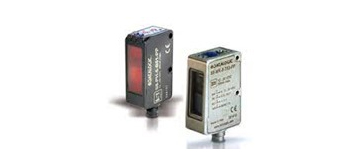 To detect transparent objects such as glass, PET bottles and packaging film, that do not completely interrupt the passage of light, a particular low-hysteresis retro-reflective version can be used.
To detect transparent objects such as glass, PET bottles and packaging film, that do not completely interrupt the passage of light, a particular low-hysteresis retro-reflective version can be used.
These retro reflective photoelectric sensors can detect the very small signal differences that the light undergoes when it passes through the transparent object.
Furthermore, the coaxial optics, with emitter and receiver lenses on the same axis, improves the detection accuracy.
The model coding used by Datasensing for the retro reflective for transparent type is "T".
Retro reflective for transparent models with coaxial optics at 2 m are available in the S8 series, either in plastic or stainless steel housing and IP69K protection.
Diffuse photoelectric sensor
Diffuse photoelectric sensors present both the emitter and receiver inside the same housing.
The light beam emitted is reflected on to the receiver directly by the object, which is detected without the need of an additional reflector.
Therefore, the diffuse sensors represent the easiest, cost effective and fastest mounting solution.
On the other hand, the excess gain is decreased and the detection distance at which they can operate is reduced to just a few meters and depends on the object's reflectivity.
The main drawback of the diffuse sensor is the difference in operating distance between a lighter object and a darker object, which will need to be closer to be detected.
Diffuse type typically operates in light mode: the output is on when an object enters the detection area and reflects the light emitted by the sensor.
The model coding used by Datasensing for the diffuse type is "C".
Fixed focus photoelectric sensor
In this diffuse photoelectric sensors, the triangulation of the optics reduces the differences in detection between light and dark objects.
The model coding used by Datasensing for the diffuse type is "D", although this version is no longer used superseded by the background suppression (see below).
Background suppression photoelectric sensor
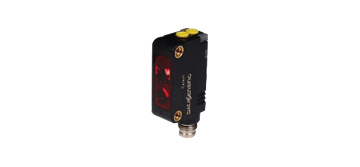 The Background suppression photoelectric sensor allows to precisely set the maximum detection distance, thanks to optic triangulation, or electronically using PSD (Position-Sensitive Detectors) receiving systems.
The Background suppression photoelectric sensor allows to precisely set the maximum detection distance, thanks to optic triangulation, or electronically using PSD (Position-Sensitive Detectors) receiving systems.
Consequently, objects can be detected at the same distance regardless of their degree of reflectivity.
Furthermore, the detection of an object is independent of other objects lying behind, or in the background, which are suppressed.
The model coding used by Datasensing for the background suppression type is "M".
The best background suppression performance in miniature sensors is available in the new S3N series, also with Laser emission.
Foreground-background suppression photoelectric sensor
The foreground and background suppression function allows to precisely set the minimum and the maximum detection distance.
Consequently, an object is detected only inside a given area, and foreground or background are suppressed.
For example, with this function it is possible to suppress the detection of a box edges and bottom, detecting only the presence of contained goods.
The model coding used by Datasensing for the foreground-background suppression type is "N".
Distance measurement photoelectric sensors
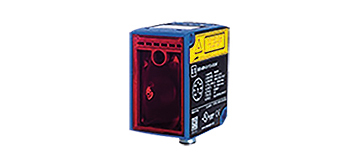 Distance measurement is typically supplied with a 0-10V or 4-20mA analog output, proportional to the distance between the photoelectric sensor and a target object.
Distance measurement is typically supplied with a 0-10V or 4-20mA analog output, proportional to the distance between the photoelectric sensor and a target object.
The main technologies that lie at the basis are optic triangulation, suitable on short distances with micrometric precision, or time of flight (ToF) ideal for medium and long distances with millimetric accuracy.
The model coding used by Datasensing for the distance measurement type is "Y".
The S85 series offers ToF laser sensors with measured distance up to 20 m and 1 mm resolution.
Contrast sensor
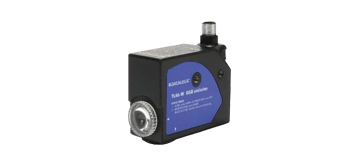 These photoelectric sensors are also defined print registration mark sensors, or color mark sensors, according to their main applications.
These photoelectric sensors are also defined print registration mark sensors, or color mark sensors, according to their main applications.
In fact, contrast sensor working principle is based on the detection of difference between the light reflection of a mark and its background.
Furthermore, in presence of colors, the contrast is highlighted using a colored light emission, typically a selectable Red, Green, or Blue, RGB LEDs.
The contrast sensors are mainly used in automatic packaging machines for register mark detection to synchronize all the folding, cutting, and welding phases; as well as in printing and flexographic machines.
Contrast and color sensors with RGB emission are available in the TL46 series, while the LD46 series includes luminescence sensors with UV emission.
Color sensor
Color sensors have typically a triple RGB LEDs light emission the detect the chromaticity of an object.
Color sensor working principle is based on the different reflection coefficients obtained on the red (R), green (G) and blue (B) light emissions, since the color of an object depends on all components of the incident light which are reflected, eliminating those which are instead absorbed.
The dominant color is defined "hue" and depends on the reflected light's wavelength; while the "saturation" indicates the pureness percentage with respect to white that represents 0%.
The hue and saturation are together defined "chromaticity" or "chromatism".
The applications are extremely common, ranging from assembling automation, to quality controls and object selection according to the color.
Luminescence sensor
Photoelectric sensors for luminescence detection emit ultraviolet light, which is reflected and detected at a higher wavelength leasing energy on a fluorescent surface, thus shifting into the visible light spectrum.
Applications range from pharmaceutical and cosmetics, where they are used to detect fluorescent labels on glass vials, to ceramics where they select tiles marked with fluorescent signs.
Other applications are in textiles, where they are used detect invisible cutting and sewing guides, to automotive to check the presence fluorescent paints or lubricants.
What products does Datasensing recommend?
Datasensing offers a complete range of photoelectric sensors and optic functions.The selection starts with the size and type of sensor case, so it is suggested to look for the desired performance in the miniature S3N, tubular S5N, fiber optic S70, compact S8, standard S62, or larger S300.
Also available are specific color and contrast sensors TL46, luminescence LD46, fork sensors SR23, and distance ToF sensors S65 or S85.

